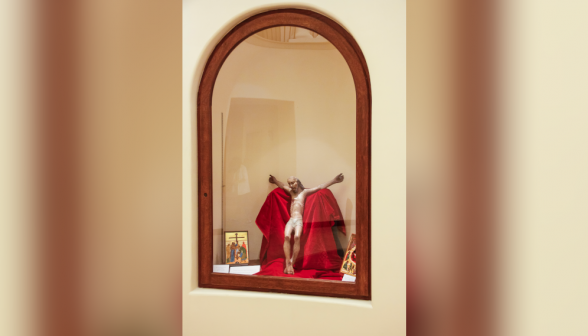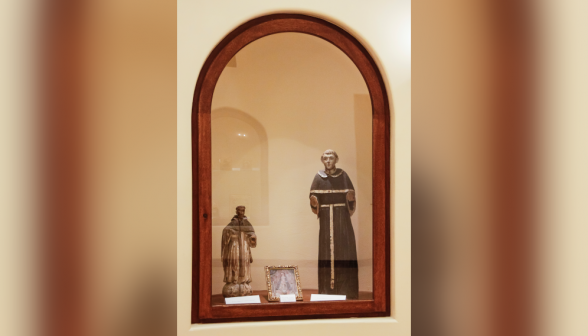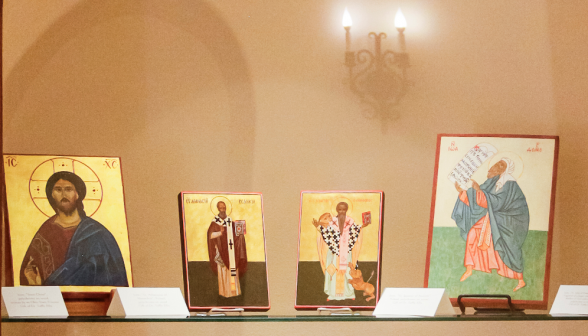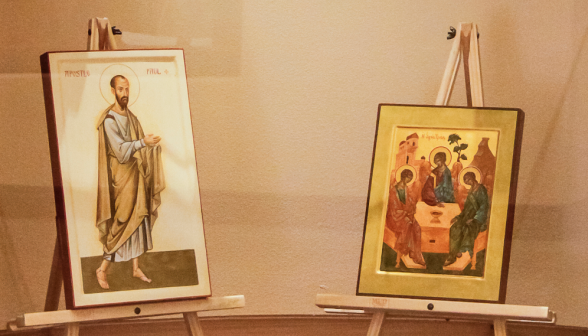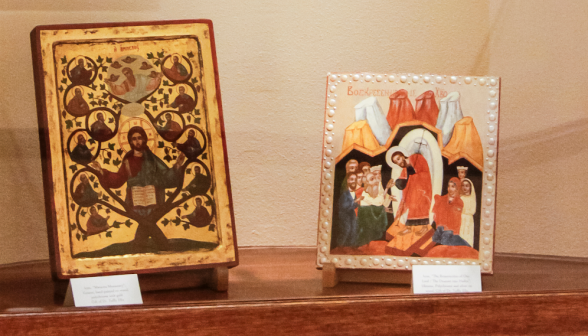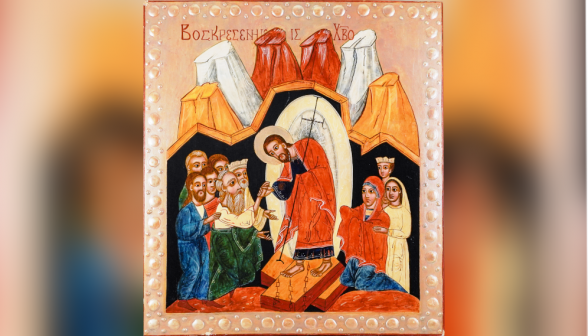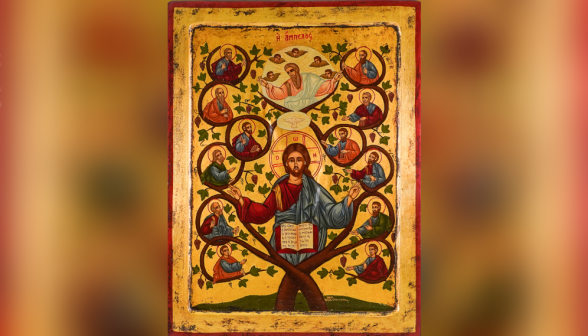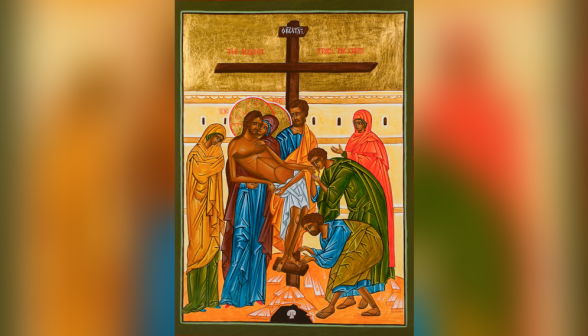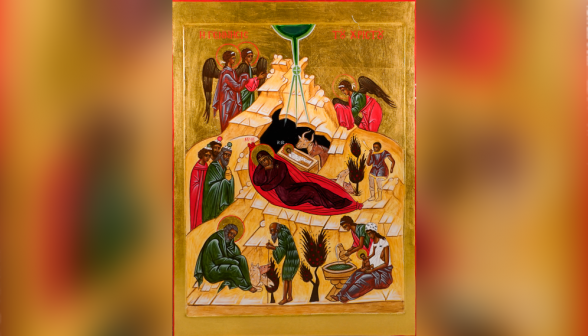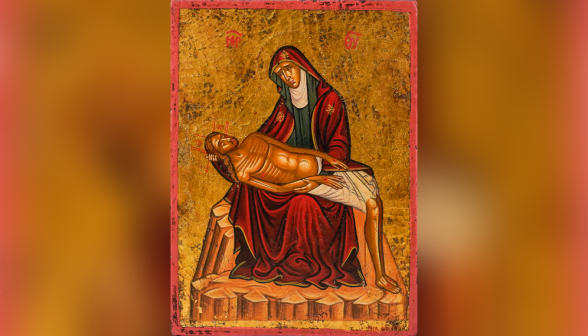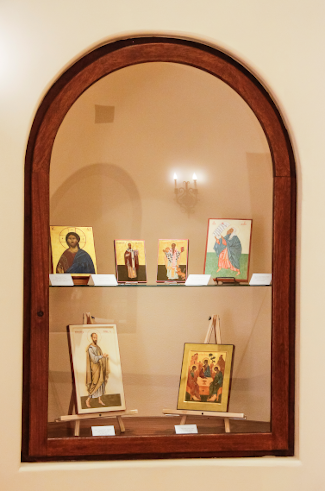 Five shipping crates recently arrived on the campus of Thomas Aquinas College, California, each of them filled with precious, carefully bubble-wrapped objects. When Paul Blewett, the College’s director of gift planning, peeled back the layers covering the first object, he found himself face to face with a saint — or rather, an image of a saint.
Five shipping crates recently arrived on the campus of Thomas Aquinas College, California, each of them filled with precious, carefully bubble-wrapped objects. When Paul Blewett, the College’s director of gift planning, peeled back the layers covering the first object, he found himself face to face with a saint — or rather, an image of a saint.
The crates held 19 pieces of devotional artwork whose origins span three centuries and nine countries, including Romania, Greece, Poland, Mexico, Ukraine, and the Philippines. The works range from Orthodox icons and Mexican retablos to Spanish Colonial santos — carved wooden statues of saints — and even a corpus, or a figure of the crucified Christ as it typically appears on a crucifix.
These sacred artworks are a gift from Dr. Tuffly Ellis of Houston, Texas, a retired professor of history at the University of Texas, former director of the Texas State Historical Association, and a longstanding benefactor of Thomas Aquinas College. Since his first gift in 1994, Dr. Ellis has established two endowments and has joined the St. Thérèse of Lisieux Legacy Society by remembering the College’s students in his estate plans. But this most recent gift is unlike any other.
“I have always enjoyed art,” says Dr. Ellis. “I had the opportunity to travel the world, and I have always been drawn to what is interesting or beautiful.”
He acquired many of the icons during his trips around the globe, including two Russian icons of the Madonna and Child and the Holy Family, which he managed to purchase in a small village outside of St. Petersburg, even though, as he says, “no one spoke English, and I didn’t speak Russian!” Many of the other works, such as the emotionally poignant Mexican corpus, were gifts from friends and colleagues who knew of Dr. Ellis’ love of art and culture. “I have been blessed in my family and friends,” he remarks.
He decided to donate these treasures to the College in no small part because of his admiration of its classical curriculum. “It took me a long time to learn what a real education is,” Dr. Ellis observes, admitting that, in his youth, he would have laughed at the idea of studying the liberal arts. Now he knows better. “Thomas Aquinas College offers the kind of education I wish I had had at that age,” he adds. Fittingly, a few of his donated icons depict authors from the College’s curriculum, including John of Damascus and Athanasius of Alexandria.
But the most important factor in his decision to make this gift was the College’s enduring loyalty to the Church: “TAC is authentically Catholic.” Though these artworks were made in widely different places and times, they are united in their intention to draw minds and hearts toward the divine. “That’s what it’s all about,” asserts Dr. Ellis, who thought that the College’s vibrant and genuinely Catholic character would make it a good home for these devotional objects.
Currently on display in the rotunda of the California campus’ faculty building, St. Thomas Hall, these icons, statues, and retablos will enrich the cultural and spiritual life of students for generations. “All beauty is meant to move us toward God,” says Mr. Blewett, who was honored to unpack the gifts and introduce them to the campus. “But devotional art is specially designed for contemplation and prayer.”
Dr. Ellis wanted to give his collection to a community of prayerful young people who would cherish its treasures not only for their historic and aesthetic significance, but who would also incorporate them into their adoration of Our Lord. “I wanted these artworks to go into the hands of TAC,” Dr. Ellis notes, “and I’m so happy they have ended up there.”
Dr. Ellis’ Gifts to Thomas Aquinas College
-
A Spanish Colonial, Mexican corpus stands between two Polish icons of the Descent from the Cross and the Nativity, written by Michal Ploski
-
Two Spanish Colonial, Filipino santos flank a Mexican retablo of Our Lady of Guadalupe
-
An icon of Christ written by an Ohio State Prisoner, two Polish icons written by Michal Ploski: St. Athanasius of Alexandria and Ignatius of Antioch, a Ukrainian icon of John of Damascus
-
An icon of Saint Paul, written by famous English iconographer Aidan Hart, and an icon of the Holy Trinity written, by Irene Perez Omar of Austin, Texas
-
A Russian icon of the Holy Family, an icon of the Pieta from Greece, and a Russian icon of the Virgin and Child
-
A Greek icon of Jesus Christ as the true vine and a Ukrainian icon of the Resurrection and Harrowing of Hell
-
Ukrainian icon of the Resurrection and Harrowing of Hell
-
Greek Icon of Christ as the true vine, the twelve apostles as the branches, and the Father and Holy Spirit above, surrounded by five angels. “I am the vine, you are the branches. Whoever remains in me and I in him will bear much fruit, because without me you can do nothing” (John 15:5).
-
Polish icon of the Descent from the Cross, written by Michal Ploski
-
Polish icon of the Nativity, written by Michal Ploski
-
 Fidelity & Excellence
Fidelity & Excellence Truth Matters
Truth Matters Under the Light of Faith
Under the Light of Faith Is TAC Right for You?
Is TAC Right for You? Mind, Body & Spirit
Mind, Body & Spirit What Can You Do with a Liberal Education?
What Can You Do with a Liberal Education?


